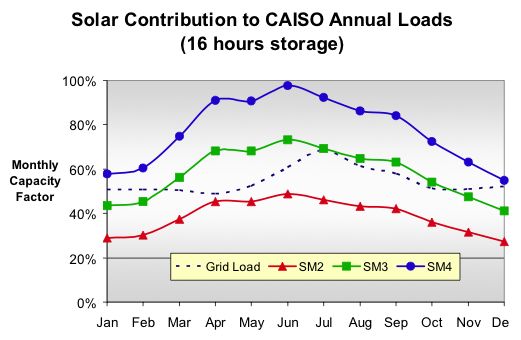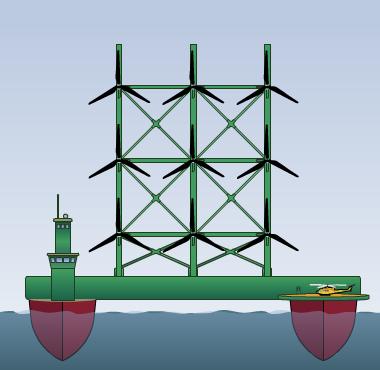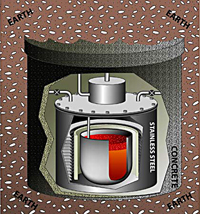Archive for the 'Storage' Category
Ausra’s Bold Claim
We’ve been tracking solar thermal for some time as it is intended to be part of our Sou Hills project in due course. One of the more interesting players to enter the fray is Ausra, an Australian company transplanted to the US and the recipient of substantial funding from Khosla Ventures. Recently, David Mills and Robert Morgan, principals in Ausra, published a paper in which the claim is made that solar thermal could account for the entire US energy supply. Here’s a link to their paper.
It’s not lost on most people that the Sun does not shine 24×7 and, in fact, that it doesn’t shine every day even in a desert environment. Thus the stunningly low capacity factors delivered by solar solutions, both thermal and PV. However, with the advent of storage (water, pumped water, capacitors, and molten salts) this is beginning to change somewhat. The thesis advanced by Mills and Morgan is that an oversized solar array matched with a huge storage system sufficient for 16 hours of operation would be able to produce at baseload levels.

The “catch” to this whole approach is that to make the system work at baseload, a developer has the added cost of sizing the solar array 3x larger than normal and installing a huge storage system. Nevada Solar One is a 64MWe project that cost somewhere north of $250M in capital to complete. That’s around $3.9M/MWe at normal sizing. If we consider that the storage system is “free” and up the size 3x, that’s $750M+ capital cost to get 64MWe baseload generation, or $11.7M/MWe. To put this in perspective, a natural gas fired plant is on the order of $1M/MWe, clean coal is $3M/MWe, geothermal is $3M/MWe.
That’s not to say that the economics won’t change, as solar thermal becomes higher volume in production, the price should drop. If the price drops by 2/3, then there is an interesting discussion to be had, because sunshine is an underutilized resource. Also, we found the discussion about oil in the paper to be specious, less than 2% of the US energy load is generated with petroleum based products. If the authors wish to be taken seriously, they would address the technology vs. coal, nuclear, and natural gas generation as they are the top 3 producers of electricity in the US.
Nevertheless, it is an interesting assertion and it’s clear we can and should do more with solar thermal harvest than is happening today. Let’s hope Ausra and their cohorts can change the economic model to make this option viable.
2 comments
Nuclear Battery
From the Santa Fe Reporter via StephenYears.com:
4 commentsThe portable nuclear reactor is the size of a hot tub. It’s shaped like a sake cup, filled with a uranium hydride core and surrounded by a hydrogen atmosphere. Encase it in concrete, truck it to a site, bury it underground, hook it up to a steam turbine and, voila, one would generate enough electricity to power a 25,000-home community for at least five years.
The company Hyperion Power Generation was formed last month to develop the nuclear fission reactor at Los Alamos National Laboratory and take it into the private sector. If all goes according to plan, Hyperion could have a factory in New Mexico by late 2012, and begin producing 4,000 of these
reactors.Though it would produce 27 megawatts worth of thermal energy, Hyperion doesn’t like to think of its product as a “reactor.†It’s self-contained, involves no moving parts and, therefore, doesn’t require a human operator.
“In fact, we prefer to call it a ‘drive’ or a ‘battery’ or a ‘module’ in that it’s so safe,†Hyperion spokeswoman Deborah Blackwell says. “Like you don’t open a double-A battery, you just plug [the reactor] in and it does its chemical thing inside of it. You don’t ever open it or mess with it.â€
Air as auto fuel?
Family Car Model

Mr. Guy Nègre of Moteur Developpment International (MDI) has created an air engine (in vehicles) that can be recharged by a compressor in 3 minutes or via an electric connection in 4 hours and has a range of 200km. The cars use regenerative braking and have models including a taxi, truck, van, runabout, and family car. An interesting approach to be sure. Energy storage in compressed air form is reasonably efficient and could be widely available. Let’s see where this concept goes… Comments are off for this post
UOIT: Thermal Energy Storage
UOIT System Diagram

Recently we ran across a short article that describes at a high level a project the University of Ontario Institute of Technology has to use geothermal resources for heating and cooling.
The system consists of three hundred and eighty-four holes, each 213 metres (700 feet) deep, will provide the basis for a highly efficient and environmentally friendly heating and cooling system, capable of regulating the temperature of university’s new buildings. A glycol solution, encased in polyethylene tubing, circulates through an interconnected, underground network. During the winter, fluid circulating through tubing extended into the wells collects heat from the earth and carries it into the buildings. In summer, the system will reverse to pull heat from the building and place it in the ground.
Windhunter
Yesterday we ran across an interesting concept, WindHunter. Effectively, this is a mobile platform with nine large wind turbines dedicated to the manufacture of hydrogen. See an image of the concept below:

The idea is to refit old single hull oil tankers (now illegal for oil transport) to support a large platform on which will be placed large (5MW) wind turbines. The power generated will be used to electrolyze water separating it into hydrogen and oxygen (the plan calls for selling the hydrogen, but oxygen is valuable too.)
While this is a large and unproven project, the potential is apparent. Since the platform is mobile, it can travel to wind rich enviroments and orient itself to optimally harvest the wind resource. It can use the water as raw material for hydrogen production as well as for cooling. The hydrogen gas sales are projected to be near $25M per year at just 25% capacity factor for the platform. Modern land-based turbines are seeing capacity factors closer to 35% and with the mobility factor, it may be possible to boost the capacity factor of the WindHunter turbines beyond that threshold.
There are certain to be technical obstacles to overcome (engineering, storm worthiness, hydrogen transport, etc) but it’s certainly a concept that should get more examination and perhaps will come into being. 1 comment









